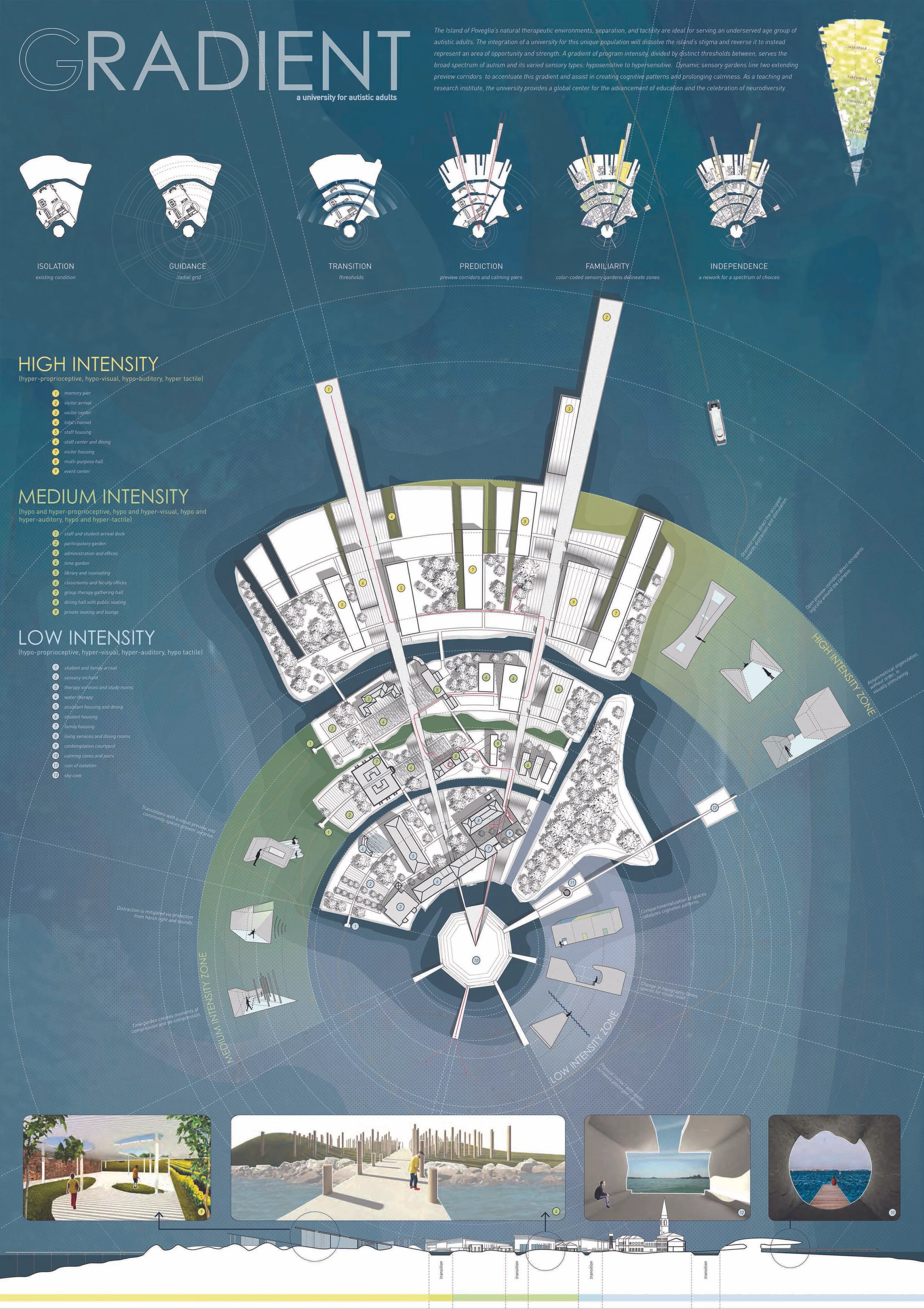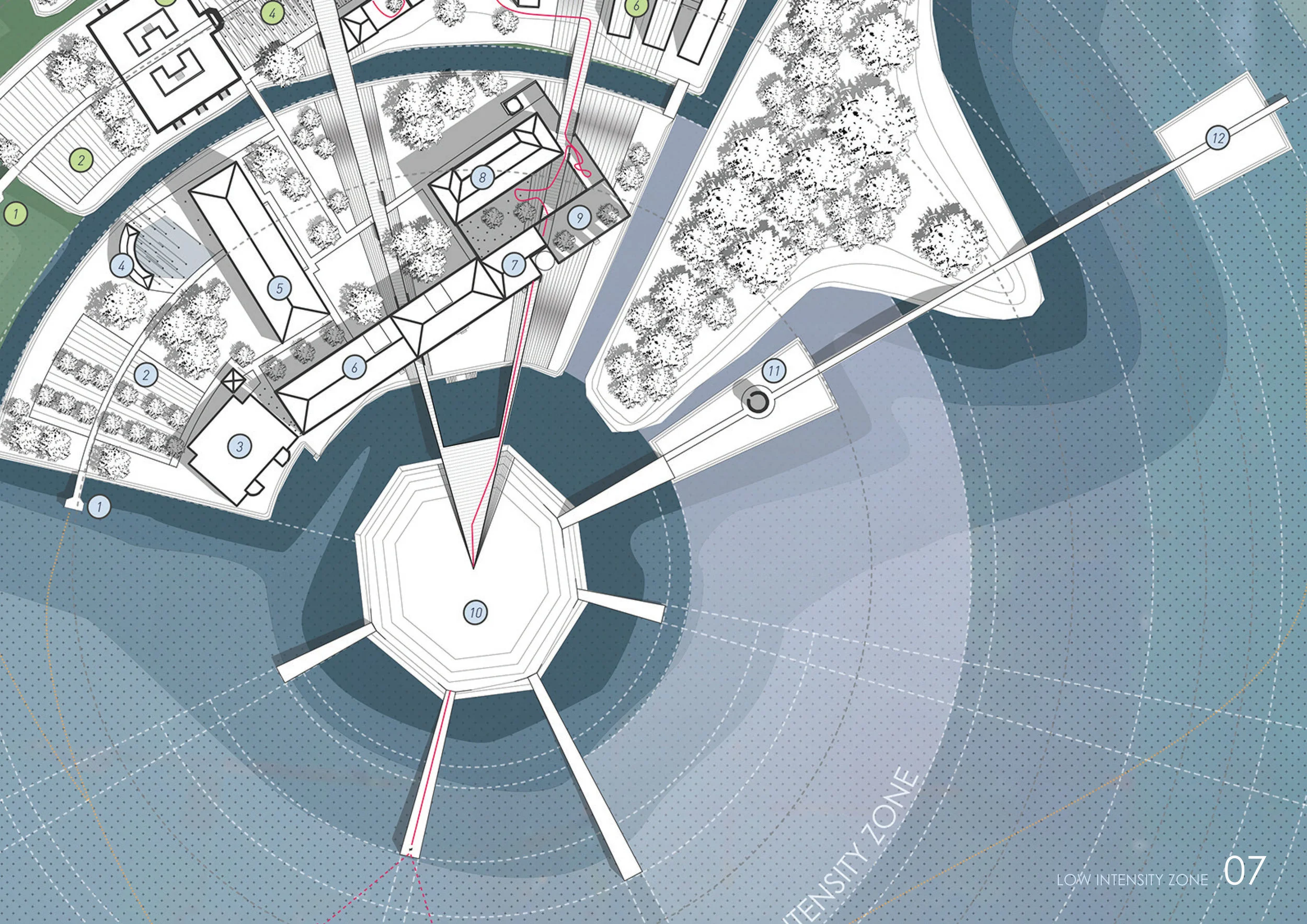UNIVERSITY ISLAND
“University Island” is an idea-based proposal for a design competition created by Young Architects Competitions (YAC). The competition calls for entries to transform the island of Poveglia, a deserted island a stone’s throw from the main islands of Venice into a spearheading study and research center. The MFx16 team was formed into three overlapping groups to tackle the program from three different intriguing angles.
Scheme 1: Unversity
An UN-versity celebrates the Island’s dark history and abandonment. This concept allows the island to remain inaccessible, in isolation, while having the design activate a radically un-isolated education network, composed of a virtual network of people within a real network of buildings.
A new central Data Tower stands as a visual and virtual beacon within a network of towers located on surrounding islands, allowing cyber education. The structure is constructed from prefabricated members that can be added as necessary, and the expansion and repair of the tower can be addressed within the architecture of the Tower itself. A mechanical process eliminates human contact almost entirely, and a large water-powered energy generator sustains the operation as well as providing cooling for the systems.
UN-versity, therefore, dominates the island without disturbing the reclamation of Poveglia by Mother Nature and counters the choice of more typical architectural intervention. Its celebration of architecture as a machine welcomes the regenerative abilities of nature.
Scheme 2: Terra Innova
From an opposite view, Terra Innova challenges cultural norms of design intervention within the natural environment by eliminating the implications of stability and control. Terra Innova achieves this via the introduction of a network of canals that shape the existing landscape at varied cadences.
The design is divided into four separate zones carved from the intersection of the existing canal and a new canal that runs along the length of the island. The living zone, preservation zone, research zone, and regenerative zones are connected by elevated paths organized along a deformed grid that is influenced by the existing landscape. These paths are also incrementally placed to join programmatic elements, and support the islanders’ mental separation from the island’s dark and unhealthy past.
Terra Innova acknowledges the inevitable threat of rising waters and embraces the necessity for ecosystems to change and fluctuate over time. It provides an environment in which faculty and students research to improve not only local but global issues regarding water pollution, animal habitat preservation, and ecological systems.
Scheme 3: Gradient
The Gradient attempts to dissolve the negative stigma of the island by instead using its isolation and natural surroundings for personal growth and independence of those with autism. The organization of the island and the incorporation of sensory responsive spaces respond to the special needs of a varied spectrum of types of autism ranging from hyper- to hypo-sensitive.
The design proposal creates a gradient from high and low intensity zones, which addresses the need for differentiation between sensory stimulating and the sensory calming program. This gradient represents variability in quality that is similar to the variation seen across the spectrum of the disorder. The separate special zones are accentuated by the erosion of past architectural forms within a frame of familiarity: the changing colors of the landscape and tidal water elements.
The Gradient scheme is a continuing in research and experimental design based on a proposal for the North Brother Island School of Autistic Children in New York City by Frances Peterson and MF Architecture’s Ian M. Ellis. Ellis also volunteers and serves as an Advisory Board Member for Magic Always Happens – a multi-disciplinary non-profit organization focused on research, testing, and implementation of innovative design regarding autism at an international scale.
Location: Poveglia, Venice, Italy | Phase: Completion entry 2016 | Project Lead: Kendall Claus | Design Team: Garret Callen, Jeremy Jackson, Ashley Dotson, Sean O’Brien, Janet Ni, Ui Jun Song, Laura Kurtz, Kendall Claus, Paul Holmes, Fiona (Yee Sang) Wong, with guidance from Sarah Wassel, Anna Katsios, Ian M. Ellis, Matt Fajkus




















































